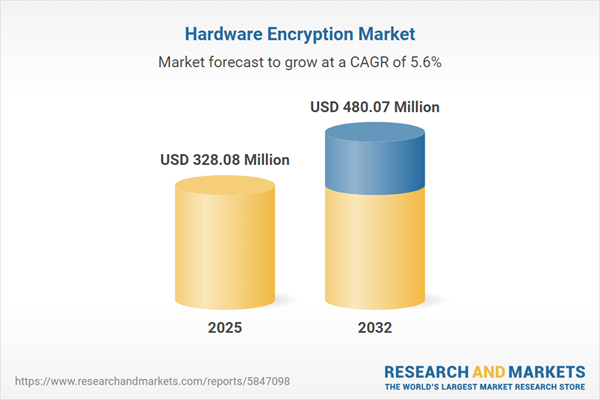Speak directly to the analyst to clarify any post sales queries you may have.
The hardware encryption market is quickly becoming essential for organizations seeking strong, scalable data protection as digital transformation accelerates across industries. This research provides a comprehensive analysis of technological advancements, regulatory pressures, and emerging trends influencing procurement and implementation decisions.
Market Snapshot: Hardware Encryption Market Size and Growth
The hardware encryption market grew from USD 311.03 million in 2024 to USD 328.08 million in 2025 and is projected to continue expanding at a CAGR of 5.57%, reaching USD 480.07 million by 2032. Growth in this sector is largely driven by heightened regulatory demand, digitalization efforts across sectors, and increasing awareness of hardware-based security's value for mission-critical infrastructures.
Scope & Segmentation of the Hardware Encryption Market
The report covers a wide range of industries, technologies, and regions, ensuring nuanced and actionable insights for strategic planning:
- End User: Banking, financial services and insurance (BFSI), energy and utilities, government and defense, healthcare, IT and telecom, retail
- Encryption Type: CPU-based encryption (AES-NI, trusted memory encryption), hardware security modules (network-attached module, PCIe card, USB token), self-encrypting drives (NVMe, SAS, SATA), software-based encryption (API-based, integrated)
- Deployment Model: Cloud, hybrid, on premises
- Application: Data at rest, data in transit, device security
- Regions: Americas, Europe/Middle East/Africa (EMEA), Asia-Pacific — with detailed insight into country-specific adoption drivers and inhibitors across North America, Latin America, Europe, the Middle East, Africa, and Asia-Pacific markets
- Key Companies: Thales S.A., UTIMACO GmbH, Futurex Inc., International Business Machines Corporation, Entrust Corporation, Cisco Systems Inc., Atos SE, Infineon Technologies AG, NXP Semiconductors N.V., STMicroelectronics N.V.
Key Takeaways for Senior Decision-Makers
- Hardware encryption is increasingly integral to regulatory compliance and risk mitigation for sectors such as finance, government, and healthcare, especially as sensitive data volumes grow.
- Integration of encryption functions into modern silicon reduces latency and operational overhead, offering efficient, high-assurance data protection across edge, cloud, and hybrid architectures.
- Adoption patterns are shaped by workload requirements and advances such as trusted execution environments, cryptographic agility, and AI-driven threat detection at the hardware layer.
- Regional regulatory frameworks, including data sovereignty in EMEA and modernization initiatives in the Americas, are key drivers influencing provider strategies and investments.
- Hardware vendors are investing in post-quantum cryptography, secure supply chains, and real-time policy enforcement to address evolving threats and compliance expectations.
- Strategic alliances with software vendors and cloud providers enable integrated, scalable encryption solutions aligned with shifting enterprise IT priorities.
Tariff Impact on Hardware Encryption Supply Chains
The imposition of new U.S. tariffs on semiconductor and encryption hardware imports has reshaped global supply chains. Vendors are responding by evaluating alternative sourcing, pursuing nearshoring and reshoring, and renegotiating contracts to offset cost pressures. Collaboration with government agencies for tariff relief and the strategic diversification of manufacturing locations are becoming standard practices to ensure sustained market competitiveness and operational resilience.
Methodology & Data Sources
The report employs primary research, including interviews with senior security, compliance, and technical leaders, complemented by secondary analysis of industry publications, regulatory white papers, and technology benchmarks. Data from vendor financials, procurement cycles, and patent filings provide a robust foundation for insights, all validated via triangulation and peer review by independent experts.
Why This Report Matters
- It equips technology and security leaders with granular insights to inform hardware encryption investments and risk management strategies.
- Market coverage by end user, technology, deployment, and region enables precise benchmarking against industry peers and identification of partnership opportunities.
- Analysis of tariff impacts and supply chain initiatives supports forward-looking procurement and business continuity planning.
Conclusion
Hardware encryption continues to evolve as a vital component of enterprise security strategies. Its adoption enables organizations to proactively address emerging risks and regulatory demands while securing their most critical digital assets.
Additional Product Information:
- Purchase of this report includes 1 year online access with quarterly updates.
- This report can be updated on request. Please contact our Customer Experience team using the Ask a Question widget on our website.
Table of Contents
3. Executive Summary
4. Market Overview
7. Cumulative Impact of Artificial Intelligence 2025
Companies Mentioned
The companies profiled in this Hardware Encryption market report include:- Thales S.A.
- UTIMACO GmbH
- Futurex, Inc.
- International Business Machines Corporation
- Entrust Corporation
- Cisco Systems, Inc.
- Atos SE
- Infineon Technologies AG
- NXP Semiconductors N.V.
- STMicroelectronics N.V.
Table Information
| Report Attribute | Details |
|---|---|
| No. of Pages | 187 |
| Published | October 2025 |
| Forecast Period | 2025 - 2032 |
| Estimated Market Value ( USD | $ 328.08 Million |
| Forecasted Market Value ( USD | $ 480.07 Million |
| Compound Annual Growth Rate | 5.5% |
| Regions Covered | Global |
| No. of Companies Mentioned | 11 |









